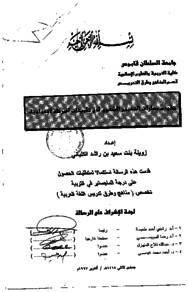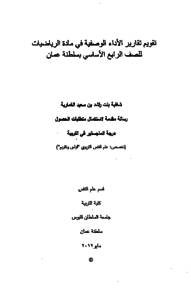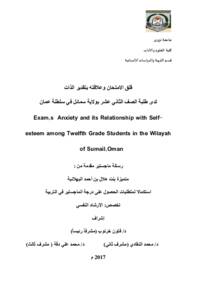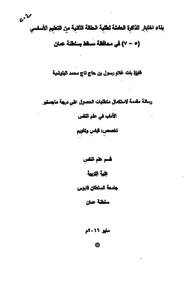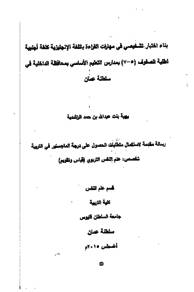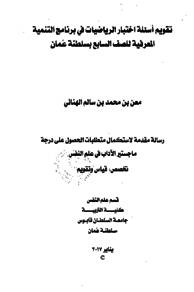وثيقة
تقويم مهارات التعبير الشفوي لدى تلميذات المرحلة الاعدادية
الناشر
جامعة السلطان قابوس
ميلادي
1998
اللغة
العربية
الملخص الإنجليزي
The Problem of this study is the notable weakness of the preparatory stage female students oral expression skills and their inability to express themselves orally in error-free, fluent Arabic. More specifically the present study tend to answer the following questions:
1)What are the most important oral expression skills which ought to be acquired by the preparatory stage female students?
2) To what extent are those skills already mastered by the preparatory stage female students? And does this mastery very according to the students grade level?
3)What is the relation between the standard of the students general linguistic performance and that of her oral expression?
In her attempt to answer these question, the researcher produced two lists . The first list comprised oral expression fields, whereas the second contained the specific skills that pertain to each field, which ought to be mastered by preparatory stage girl-students.
After the validation of these lists, they were both administered to a sample of Arabic school-teachers and inspectors who belonged to five different Omani educational regions, viz. Al-Dhahira, Al-Dakhiliya, Al-Batinah, Musandam and Muscat, in quest of opinions regarding the most appropriate oral expression types and its specific skills for female students in the preparatory stage. The types that achieved the highest scores of frequency were respectively:
(0.95) • story - telling and anecdotes (0.94) • speech - making (0.93) •conservation and discussion (0.89) •description (0.88) •reading of images and illustrations (0.85) • telephone conversation (0.85) • interview (0.84) • oral report presentation (0.83) giving instructions.
These were the types on which the subjects, opinions were brought, totaling 30 girl - students of the three different classes, were tested, with the aim of assessing their mastery of the oral expression constituent skills, using the content analysis card for analyzing the preparatory stage girl-students' videotaped oral performance.
This card consists of the major oral expression skills broken up into ten levels and (58) skills as well as a card of the qualitative skills specific to each of the fields of discourse covered by the students in the experiment.
The researcher chose to use the content analysis technique, to which she subjected all the videotaped discourse of the female students.
The statistical techniques used in their study were: One Way ANOVA, the Scheffle test of Multiple Comparisons, and the Person Product Moment Correlation Coefficient.
The following were the major conclusions of the study:
(a) There were no statistically significant differences between the preparatory stage female students' (of all three classes) average scores in respect of the skills pertaining to the following: • content • rules (of grammar) • phonemes or sound • speed and fluency rate • courtesy • speaker's appearance and psychological traits • use of appropriate gestures.
(b) There were statistically significant differences (0.05) - only between students of the first prep and those of the third prep classes, favoring the third prep class students, in respect of the skills linked to the standard of thought and use of appropriate gestures.
© The preparatory female students' standard in the specific skills necessary for the following oral expression fields was low : • reading images and illustrations • story-telling and anecdotes completion of verbal stories • conversations and dialogue • speech-making • discussions • debate • congratulation • telephone conversations • given instructions • personal introductions • apologies • descriptions .
There were statistically significant differences (0.001) between third prep and first prep classes, favoring the third prep class students as regards the time spent by students in discourse. There was a positive significant correlation between the general linguistic perfor-mance and oral expression skills for the preparatory stage girl students and for the second preparatory students. In addition, the results indicated that there was no significant correlation between the general linguistic performance and oral expression skills for the first and third preparatory students. In the light of the above conclusions, the researcher proposed the following recommendations:
(1) To ensure that Arabic syllabus skills of the preparatory stage are balanced and that no one skill is allowed to take precedence over the others.
(2)To pay more attention to the fields of oral expression most necessary for the students in their academic, practical and social lives.
(3) To train Arabic school teachers sufficiently in the different basic and qualitative skills of oral expressions, and also to acquaint them with the different expressive fields, their importance, their specifications, norms of their mastery, methods of developing the student's competence in such fields, and lastly the sound foundations of their evaluation.
(4)To design remedial courses for those students who demonstrate slowness in achieving any of the Arabic curriculum aspects or skills.
The study also recommends that coordination with both the school social worker and the Arabic inspectors should be encouraged. The study has furthermore included some suggestions for future research to be carried out in pursuit of the development of Arabic Language teaching and upgrading its levels in Oman.
المجموعة
URL المصدر
الملخص العربي
تمثلت مشكلة الدراسة الحالية في ضعف مستوى تلميذات المرحلة الإعدادية في مهارات التعبير الشفوي ، وتدني مستواهن وعجزهن عن التعبير عن أنفسهن بلغة شفوية عربية صحيحة سلسة خالية من الأخطاء والعيوب . وللتصدي لحل هذه المشكلة حاولت الدراسة الحالية الإجابة عن الأسئلة التالية :
1- ما أهم مهارات التعبير الشفوي التي ينبغي أن تكتسبها تلميذات المرحلة الإعدادية ؟
2- إلى أي مدى تتوافر هذه المهارات لدى تلميذات المرحلة الإعدادية ؟ وهل تختلف هذه المهارات باختلاف المستوى الصفي؟
3- ما العلاقة بين مستوى الأداء اللغوي العام لدى التلميذات وبين أدائهن في مهارات التعبير الشفوي ؟
وللإجابة عن هذه الأسئلة قامت الباحثة بإعداد قائمتين تضمنت إحداهما: مجالات التعبير الشفوي ، والأخرى تضمنت المهارات النوعية الخاصة بكل مجال ، واللازمة لتلميذات المرحلة الإعدادية ، وبعد التأكد من صدقهما، تم توزيعهما على عينة من معلمي اللغة العربية وموجهيها بخمس مناطق تعليمية بالسلطنة وهي : منطقة الظاهرة ، ومنطقة الداخلية ، ومنطقة الباطنة ، ومحافظة مسندم ، ومحافظة مسقط ؛ لاستطلاع أرائهم في المجالات المناسبة للتعبير الشفوي ومهاراته النوعية اللازمة لتلميذات المرحلة الإعدادية ، وقد كانت المجالات التي حصلت على أعلى نسبة من التكرارات هي : سرد القصص والحكايات (95ر) ، والخطابة (94ر) ، والمحادثة والمناقشة (93ر) ، والوصف (89) ، وقراءة الصور والرسوم (88ر) ، والحديث في الهاتف (85ر) ، والمقابلة الشخصية (85) ، وعرض التقارير الشفوية (84ر) ، وإلقاء التعليمات والتوجيهات (83ر) ، وهي الموضوعات التي استثيرت عينة الدراسة للتحدث فيها ، والتي بلغت (۳۰) تلميذة من تلميذات الصفوف الثلاثة بالمرحلة الإعدادية ؛ لقياس مدى تمكنهن من المهارات الأساسية للتعبير الشفوي ، باستخدام بطاقة تحليل محتوى الأداء المسجل على سفطات الفيديو التلميذات المرحلة الإعدادية ، التي تتضمن مهارات التعبير الشفوي الأساسية ، مقسمة إلى عشرة مستويات تضم ثماني وخمسين مهارة ، وبطاقة المهارات النوعية الخاصة بكل مجال من المجالات التي تحدثت فيها التلميذة .
وقد استخدم أسلوب تحليل المحتوى ؛ لتحليل الأحاديث الشفوية المسجلة على سفطات الفيديو التلميذات . وللإجابة عن السؤال الأول والثاني في هذه الدراسة فقد تم استخدام المتوسطات والانحرافات المعيارية والنسب المئوية ؛ وتحليل التباين الأحادي ، واختبار شيفيه للمقارنات المتعددة البعدية ، وللإجابة عن السؤال الثالث تم استخراج معاملات الارتباط (بيرسون بين الأداء اللغوي العام وبين مهارات التعبير الشفوي .
وقد أسفرت الدراسة الحالية عن مجموعة من النتائج تمثلت أهمها فيما يلي : أ- لا توجد فروق ذات دلالة إحصائية بين متوسط درجات التلميذات في الصفوف الثلاثة من المرحلة الإعدادية في المهارات المرتبطة بالمستويات التالية : ( المحتوى - القواعد أ- الأصوات- معدل السرعة. والطلاقة - المجاملة - هيئة المتحدثة وسماتها النفسية - استخدام الإشارات المناسبة ).
ب - توجد فروق ذات دلالة إحصائية عند مستوى ( 0=05ر) فقط بين تلميذات الصفين : الثالث الإعدادي والأول الإعدادي ، لصالح تلميذات الصف الثالث الإعدادي في المهارات المرتبطة بمستوى الأفكار ، واستخدام الإشارات المناسبة .
ج - لوحظ تدني مستوى تلميذات المرحلة الإعدادية في المهارات النوعية الخاصة بمجالات التعبير الشفوي التالية : قراءة الصور والرسوم - وسرد القصص والحكايات - وإكمال القصص الشفوية - والمحادثة والحوار - والخطابة - والمناقشة - والمناظرة - والتهنئة - والحديث في الهاتف ، وإلقاء التعليمات والتوجيهات، والتعارف بين الأفراد - والاعتذار - والوصف .
د - توجد فروق ذات دلالة إحصائية عند مستوى ( 05 = ر) بين تلميذات الصف الثالث الإعدادي ، وتلميذات الصف الأول الإعدادي ، وتلميذات الصف الثاني الإعدادي ، لصالح تلميذات الصف الثالث الإعدادي ، في الزمن الذي استغرقته التلميذات في التحدث .
ه - توجد علاقة دالة بين الأداء اللغوي العام وبين مهارات التعبير الشفوي لدى تلميذات المرحلة الإعدادية ، وكذلك بالنسبة للصف الثاني الإعدادي ، بينما لم تشر النتائج إلى وجود علاقة دالة بين الأداء اللغوي العام وبين مهارات التعبير الشفوي بالنسبة للصفين الأول الإعدادي ، والثالث الإعدادي . وفي ضوء تلك النتائج أوصت الدراسة بما يلي :
1- أهمية مراعاة التوازن في تقديم مهارات اللغة العربية بالمرحلة الإعدادية ؛ بحيث لا يسمح المهارة أن تنمو على حساب مهارة أخرى .
2 - توجيه المزيد من الاهتمام والعناية بمجالات التعبير الشفوي ، التي تحتاج إليها التلميذات في حياتهن العلمية والعملية والاجتماعية .
3 - تدريب معلمات اللغة العربية على التمكن من مهارات التعبير الشفوي الأساسية منها والنوعية ، وتعريفهن بالمجالات التعبيرية المختلفة ، وأهميتها ، ومواصفاتها ، ومعايير الاتقان فيها، والأساليب الكفيلة بتنميتها لدى التلميذات ، وتزويدهن بالأسس السليمة لتقويمها .
4 - الاهتمام بتصميم برامج علاجية للتلميذات اللائي يظهرن تأخرا في أحد فروع اللغة العربية أو أحد فنونها ، ويمكن مشاركة المشرفة الاجتماعية ، وموجهي اللغة العربية ، كما عرضت الدراسة الحالية مقترحات ببعض البحوث الأخرى التي يمكن أن يسهم في تطوير تعليم اللغة العربية ورفع مستواه في سلطنة عمان .
1- ما أهم مهارات التعبير الشفوي التي ينبغي أن تكتسبها تلميذات المرحلة الإعدادية ؟
2- إلى أي مدى تتوافر هذه المهارات لدى تلميذات المرحلة الإعدادية ؟ وهل تختلف هذه المهارات باختلاف المستوى الصفي؟
3- ما العلاقة بين مستوى الأداء اللغوي العام لدى التلميذات وبين أدائهن في مهارات التعبير الشفوي ؟
وللإجابة عن هذه الأسئلة قامت الباحثة بإعداد قائمتين تضمنت إحداهما: مجالات التعبير الشفوي ، والأخرى تضمنت المهارات النوعية الخاصة بكل مجال ، واللازمة لتلميذات المرحلة الإعدادية ، وبعد التأكد من صدقهما، تم توزيعهما على عينة من معلمي اللغة العربية وموجهيها بخمس مناطق تعليمية بالسلطنة وهي : منطقة الظاهرة ، ومنطقة الداخلية ، ومنطقة الباطنة ، ومحافظة مسندم ، ومحافظة مسقط ؛ لاستطلاع أرائهم في المجالات المناسبة للتعبير الشفوي ومهاراته النوعية اللازمة لتلميذات المرحلة الإعدادية ، وقد كانت المجالات التي حصلت على أعلى نسبة من التكرارات هي : سرد القصص والحكايات (95ر) ، والخطابة (94ر) ، والمحادثة والمناقشة (93ر) ، والوصف (89) ، وقراءة الصور والرسوم (88ر) ، والحديث في الهاتف (85ر) ، والمقابلة الشخصية (85) ، وعرض التقارير الشفوية (84ر) ، وإلقاء التعليمات والتوجيهات (83ر) ، وهي الموضوعات التي استثيرت عينة الدراسة للتحدث فيها ، والتي بلغت (۳۰) تلميذة من تلميذات الصفوف الثلاثة بالمرحلة الإعدادية ؛ لقياس مدى تمكنهن من المهارات الأساسية للتعبير الشفوي ، باستخدام بطاقة تحليل محتوى الأداء المسجل على سفطات الفيديو التلميذات المرحلة الإعدادية ، التي تتضمن مهارات التعبير الشفوي الأساسية ، مقسمة إلى عشرة مستويات تضم ثماني وخمسين مهارة ، وبطاقة المهارات النوعية الخاصة بكل مجال من المجالات التي تحدثت فيها التلميذة .
وقد استخدم أسلوب تحليل المحتوى ؛ لتحليل الأحاديث الشفوية المسجلة على سفطات الفيديو التلميذات . وللإجابة عن السؤال الأول والثاني في هذه الدراسة فقد تم استخدام المتوسطات والانحرافات المعيارية والنسب المئوية ؛ وتحليل التباين الأحادي ، واختبار شيفيه للمقارنات المتعددة البعدية ، وللإجابة عن السؤال الثالث تم استخراج معاملات الارتباط (بيرسون بين الأداء اللغوي العام وبين مهارات التعبير الشفوي .
وقد أسفرت الدراسة الحالية عن مجموعة من النتائج تمثلت أهمها فيما يلي : أ- لا توجد فروق ذات دلالة إحصائية بين متوسط درجات التلميذات في الصفوف الثلاثة من المرحلة الإعدادية في المهارات المرتبطة بالمستويات التالية : ( المحتوى - القواعد أ- الأصوات- معدل السرعة. والطلاقة - المجاملة - هيئة المتحدثة وسماتها النفسية - استخدام الإشارات المناسبة ).
ب - توجد فروق ذات دلالة إحصائية عند مستوى ( 0=05ر) فقط بين تلميذات الصفين : الثالث الإعدادي والأول الإعدادي ، لصالح تلميذات الصف الثالث الإعدادي في المهارات المرتبطة بمستوى الأفكار ، واستخدام الإشارات المناسبة .
ج - لوحظ تدني مستوى تلميذات المرحلة الإعدادية في المهارات النوعية الخاصة بمجالات التعبير الشفوي التالية : قراءة الصور والرسوم - وسرد القصص والحكايات - وإكمال القصص الشفوية - والمحادثة والحوار - والخطابة - والمناقشة - والمناظرة - والتهنئة - والحديث في الهاتف ، وإلقاء التعليمات والتوجيهات، والتعارف بين الأفراد - والاعتذار - والوصف .
د - توجد فروق ذات دلالة إحصائية عند مستوى ( 05 = ر) بين تلميذات الصف الثالث الإعدادي ، وتلميذات الصف الأول الإعدادي ، وتلميذات الصف الثاني الإعدادي ، لصالح تلميذات الصف الثالث الإعدادي ، في الزمن الذي استغرقته التلميذات في التحدث .
ه - توجد علاقة دالة بين الأداء اللغوي العام وبين مهارات التعبير الشفوي لدى تلميذات المرحلة الإعدادية ، وكذلك بالنسبة للصف الثاني الإعدادي ، بينما لم تشر النتائج إلى وجود علاقة دالة بين الأداء اللغوي العام وبين مهارات التعبير الشفوي بالنسبة للصفين الأول الإعدادي ، والثالث الإعدادي . وفي ضوء تلك النتائج أوصت الدراسة بما يلي :
1- أهمية مراعاة التوازن في تقديم مهارات اللغة العربية بالمرحلة الإعدادية ؛ بحيث لا يسمح المهارة أن تنمو على حساب مهارة أخرى .
2 - توجيه المزيد من الاهتمام والعناية بمجالات التعبير الشفوي ، التي تحتاج إليها التلميذات في حياتهن العلمية والعملية والاجتماعية .
3 - تدريب معلمات اللغة العربية على التمكن من مهارات التعبير الشفوي الأساسية منها والنوعية ، وتعريفهن بالمجالات التعبيرية المختلفة ، وأهميتها ، ومواصفاتها ، ومعايير الاتقان فيها، والأساليب الكفيلة بتنميتها لدى التلميذات ، وتزويدهن بالأسس السليمة لتقويمها .
4 - الاهتمام بتصميم برامج علاجية للتلميذات اللائي يظهرن تأخرا في أحد فروع اللغة العربية أو أحد فنونها ، ويمكن مشاركة المشرفة الاجتماعية ، وموجهي اللغة العربية ، كما عرضت الدراسة الحالية مقترحات ببعض البحوث الأخرى التي يمكن أن يسهم في تطوير تعليم اللغة العربية ورفع مستواه في سلطنة عمان .
قالب العنصر
الرسائل والأطروحات الجامعية

